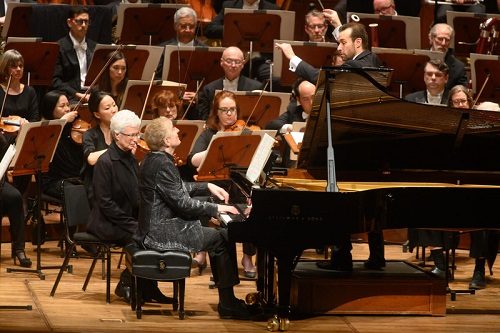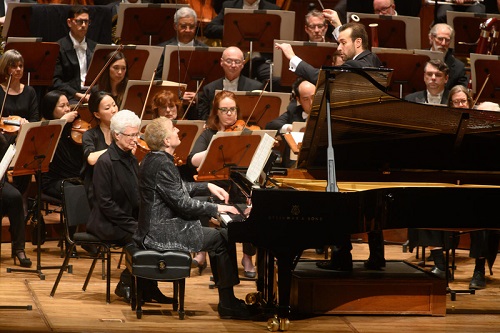 United States Dukas, Zigman, Saint-Saëns: Jean-Yves Thibaudet (piano), Jonathon Dimmick (organ), San Francisco Symphony / Fabien Gabel (conductor). Davies Symphony Hall, San Francisco, 15.2.2020. (HS)
United States Dukas, Zigman, Saint-Saëns: Jean-Yves Thibaudet (piano), Jonathon Dimmick (organ), San Francisco Symphony / Fabien Gabel (conductor). Davies Symphony Hall, San Francisco, 15.2.2020. (HS)

Dukas — La Péri, Fanfare
Aaron Zigman — Tango Manos, Concerto for piano and orchestra (US premiere)
Saint-Saëns — Symphony No.3 in C minor Op.78, ‘Organ’
When he was a 1996 conservatory student in Paris, Fabien Gabel won first prize in trumpet, so it is not surprising that his guest conducting debut with the San Francisco Symphony got off to a majestic start with the gaudy fanfare that opens Paul Dukas’s ballet La Péri. Brass ensembles love to play it, and the technically demanding score is bracing, but the full ballet, which premiered in 1912, seldom appears in concert halls.
That might be because after that opening fanfare, the plush, sweet, oleaginous music that follows never seems to let up. In the second of three performances, it certainly made for a rich first course, like having a banana split for an appetizer. The rest of the concert continued at the same level of indulgence — an overload of ice cream, whipped cream and chocolate sauce that seldom allowed for much delicacy.
The chief offender in this regard was the U.S. premiere of a concerto written for the redoubtable French pianist Jean-Yves Thibaudet. Veteran California-born film composer Aaron Zigman — best known for his score for The Notebook — met up with Thibaudet when they shared keyboard duties in recording Zigman’s score to the 2017 film Wakefield. They struck up a friendship that led to a commission from the China Philharmonic in Beijing, where artistic director Long Yu and Thibaudet hatched the idea for a tango-themed concerto.
The result, a co-commission with the San Francisco Symphony and Radio France, wowed the audience, which rewarded it (and Thibaudet’s athletic playing) with a rousing standing ovation. On closer inspection, however, the music left some of us underwhelmed.
I happen to love the tango — its insinuating rhythms, melodic turns that range from painful to sublime, harmonies that seem to squeeze the heart. Astor Piazzolla is a hero to me. Argentina’s tango orchestras thrill me. So does the sound of tango’s characteristic instrument, the bandoneon — which never makes an appearance in this score. Not even an accordion, the hallmark of the French salon style.
Oh, there’s plenty of muscular rhythm, but Zigman miscalculated with a phalanx of percussionists peppering the score with claves and various shakers related to other Latin American forms — but not tango. It’s like adding a drum set to a string quartet. The result is a sort of splashy cousin to the tango, more concerned with ear candy than real intensity.
The best parts of Zigman’s concerto are slow, lyrical sections, where soft contours and gentleness deliver a welcome respite from all that showiness. Each of the three movements starts with a rhapsodic piano solo, which Thibaudet dispatched with élan, but the score doesn’t really find its footing until the final pages. Here the piano and a soft-focus orchestra breathed with an honesty that earlier pages missed.
In the second half, Saint-Saëns’s popular and colorful Third Symphony delivered a more balanced main course. Music director of the Orchestre Symphonique de Québec since 2012, Gabel shaped an artfully balanced traversal, finding precise balances in the organ’s nudge of an entrance, and just the right sense of nervousness in the first-movement theme. He fashioned a lithe and supple slow movement, stepping up in the finale to a sonorous finish.
The orchestra’s regular organist, Jonathon Dimmick, contributed tasteful chords and gently placed low notes to extend the orchestra’s sound, rising to a full-throated opulence in the final pages without stepping on the full ensemble.
Harvey Steiman
